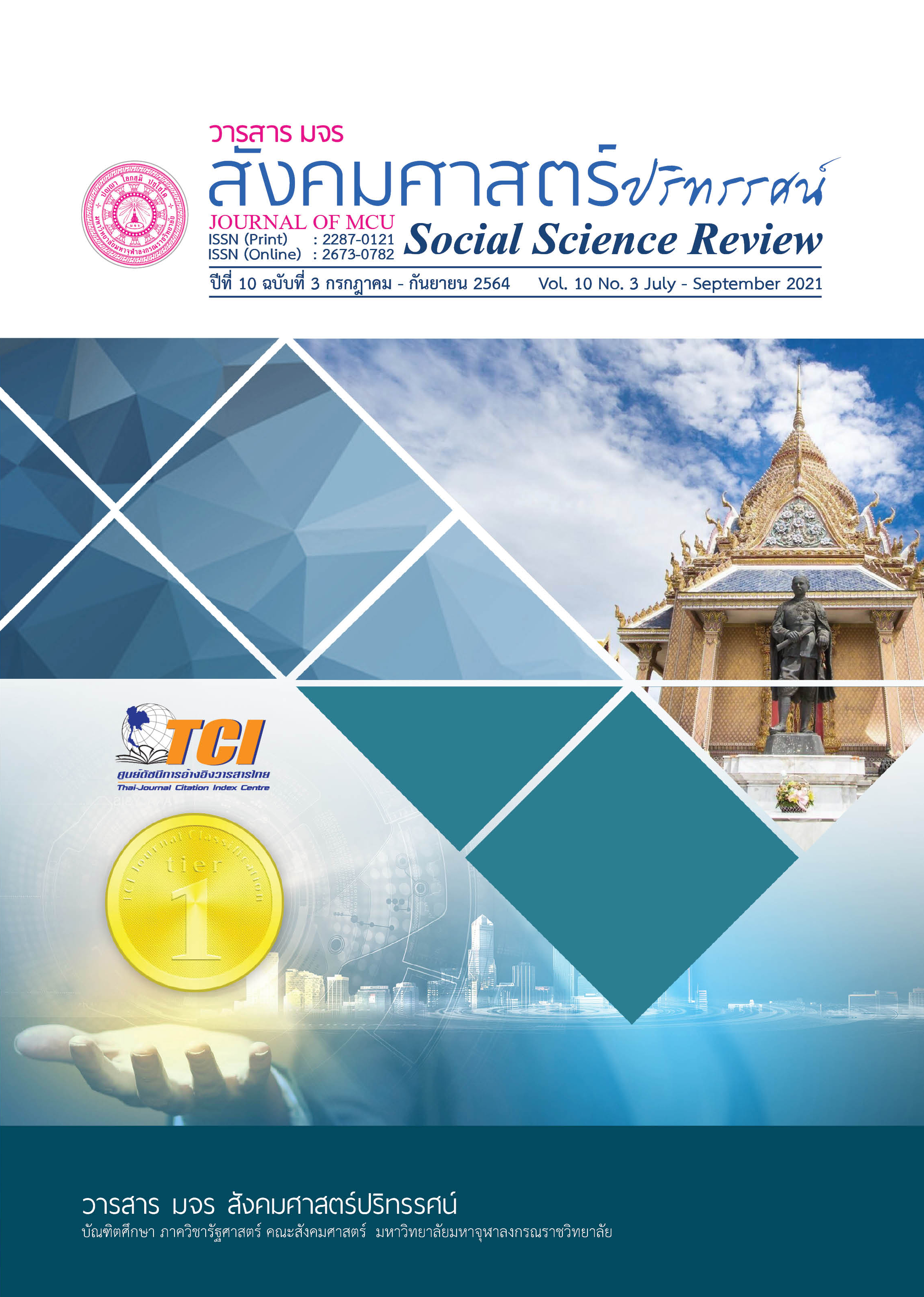ความเปลี่ยนแปลง “คำขอ” ต่อเจ้าพ่อศรีนครเตา ในอาณาบริเวณพื้นที่ทุ่งกุลาร้องไห้ ในช่วงหลังปี 2500–ปัจจุบัน
คำสำคัญ:
คำขอ, ทุ่งกุลาร้องไห้, เจ้าพ่อศรีนครเตาบทคัดย่อ
หมุดหมายของบทความต้องการนำเสนอความเปลี่ยนแปลงของ “คำขอ” ที่ชุมชนท้องถิ่นในอาณาบริเวณพื้นที่ “ทุ่งกุลาร้องไห้”ปฏิบัติต่อ “เจ้าพ่อศรีนครเตา” ตั้งแต่ปี 2500-2560 “คำขอ” จึงมิใช่เพียง คำกล่าวที่แสดงถึงความผูกพันธ์และการสยบยอมต่ออำนาจศักดิ์สิทธิ์ของเจ้าพ่อศรีนครเตาเท่านั้น ทว่ายังมีความซับซ้อนที่ฝังแฝงไปด้วยความหวัง ความปรารถนาของชุมชนและผู้คนในอาณาบริเวณทุ่งกุลาร้องไห้ขณะที่เปล่งวาจาออกไป ผลการศึกษาพบว่าคำขอก่อนปี 2500 เกี่ยวข้องกับระบบการผลิตของสังคมชาวนาเป็นสำคัญ เช่น ขอให้ฝนตกตามฤดูกาลซึ่งนำมาสู่ความอุดมสมบูรณ์ของผลผลิตทางการเกษตรและห่วงโซ่อาหารในระบบนิเวศวิทยาทางเศรษฐกิจ ขอความปลอดภัยและความสงบสุขให้เกิดแก่ชุมชน ขณะเดียวกันคำขอในระดับปัจเจกบุคคลให้ความสำคัญกับระบบสุขภาพตนเอง ครอบครัวและสัตว์เลี้ยงรวมทั้งเรื่องทรัพย์สินที่สูญหาย เป็นต้น อย่างไรก็ดีหลังปี 2500 เมื่อรัฐส่วนกลางเข้ามาดำเนินการพัฒนาโครงสร้างทางเศรษฐกิจสังคม โดยเฉพาะเส้นทางคมนาคม การศึกษา การสาธารณะสุขและสาธารณูปโภคอื่นๆ ทำให้ “คำขอ”ต่อเจ้าพ่อ ศรีนครเตาแปรเปลี่ยนไปตามความเปลี่ยนแปลงทางเศรษฐกิจสังคมอย่างซับซ้อน
เอกสารอ้างอิง
Asakit, S. (2018, 6 March). Muang tao village. [Interview].
Chanwith, P. (2011). Lecture of 60th Anniversary of Department of Economics Thammasat. Bangkok: Open books.
Chinnarat, C (2017, 6 March). Muang tao village. [Interview].
Darawan, S. (2017, 6 March). Muang tao village. [Interview].
Duangwiset, N. (2017). Anthropological concept in the studies of Secret Belief in Thailand. Journal in Humanities and Social Science Burapha University, 25(47), p. 179.
Eowsriwong, N. (2015, 25 September). Ancestors’ ghost. Weekly Matichon. p. 36-37.
Hobsbawm, E. & Terence R. (ed). (1983). The Invention of Tradition. Cambridge : Cambridge University, Press.
Kamon, B. (2009). The Study of the Legend of Chaw Pho Srinakhon Tao and thesustainable development of Ban Munang Tao, Phayakaphoomisai district, Mahasarakham province (Research report). Bangkok: Thailand Research Fund.
Kenyotha, N. (2008). The Unity of diverse ethnic groups: a case study of Phaikha, Chomphonburi District, Surin province. (Research report). Bangkok: Thailand Research Fund.
Kitiarsa, P. (2014). New way of isan. Bangkok: Wiphasa.
Lao-an, T. (2010). The Changing economy of Isan’s farmer society from 1959-2007, a case study at Ban Kukasing, Roi Et Province. (Master dissertation). Chiang Mai: Chiang Mai University, p.61
Litthidej, P. (2007). The Adaptation of Farmer Community at Thung Kula Ronghai. Mahasarakham (Doctoral dissertation). Mahasarakham: Mahasarakham University.
Mukdawijitra, Y. (2005). The Reading of “Community Culture”: Rhetorical and Political ethnic. Bangkok: Fadiawkan.
Munmanee, S. (2017). The Legend of Thung Kula Ronghai: Narrative in eco conceptand social space, Mahasarakham: (Master dissertation). Mahasarakham: Mahasarakham University.
Natsupha, C. (1998). Theory of Farmer’s economy. Bangkok: Withi That.
Patsirimongkhon, T. (2018, 7 March). Muang tao village. [Interview].
Phonsena, K. (2018, 6 March). Muang tao village. [Interview].
Phueksom, T. (2009). Local Healthcare: history and memory. Bangkok: Chronicle Office and the Museum of Thai healthcare, Research Center of Society and Health,Ministry of Healthcare.
Phusongchan, D. (2003). History of Thung Kula Ronghai (2nd ed). Bangkok: Matichon.
Ramitanon, C. (2002). Phi Chaw Naj. (2nd ed). Chiang Mai: Ming Muang.
Samutthakup, S. (1995). Gravel- Stone- Soil-Sand: State, Capitalism and Isan farmers in the Globalization. Nakhon Ratchasima: Suranaree University of Technology.
Samutthakup, S. (1997). Thai way of thinking: Phi Fa ceremony in Nakhon Ratchasima. Nakhon Ratchasima: Somboon Printing.
Satayanuruk, A. (2015). The changing remote area in the context of Thai democracy: Democracy on the move. Bangkok: Office of Thai Research Fund.
Sawameechai, S. (2018, 12 May). Phaikha villager. [Interview].
Sawannatat, B. (2010). Chronicles of Surin province (2nd ed). Surin: Rungthanakiet Printing.
Seangngam, T. (2019, 6 March). Kukasing villager. [Interview].
Songsiri, W. (2014). Cultural Leader (2nd ed).Bangkok: Lek Praphaiwiriyaphan Foundation.
Srisuvoranan, N. (1969). History of Thai Laos- Isan. Bangkok: Mitnara Pringting.
Swatdirum, T. (2020, 5 September). Phaikha villager. [Interview].
Theerasasawat, S. & Wayuphak, C. (1995). Role of Japanese vehicles in isan’s economy transformation after the World War II. Khonkaen: Research report of Khonkaen University.
Theerasasawat, S. (2014). History of Isan 2322-2488 vol.1. Khonkaen: Klang Nanawithaya.
Thianthaworn, A. (1989). Chaw Pho Srinakhon Tao: Role and significance of Ritual Ghosts in Northeast of Thailand, a case study at Ban Muang Tao, Phayakaphoomisai district, Mahasarakham province. (Master dissertation). Bangkok: Silapakhon University.
Triwiset, L. (2020, 5 September). Kukasing villager. [Interview].
Vallipodom, S. (2014). Local history operations. Bangkok: Lek - Praphaiwiriyaphan Foundation.
Wiphakphotchanakit, T. (2014). History of Isan (5th ed.). Bangkok: Samlada.
Wongthet, S. (2003). “Thung Kula, the Kingdom of Salt in 1957” from the primitive to the Rice security. Bangkok: Matichon.
Yothachan, A. (2018, 8 March). Nongkok-Nongyang villager. [Interview].
ดาวน์โหลด
เผยแพร่แล้ว
รูปแบบการอ้างอิง
ฉบับ
ประเภทบทความ
สัญญาอนุญาต
ลิขสิทธิ์ (c) 2021 วารสาร มจร สังคมศาสตร์ปริทรรศน์

อนุญาตภายใต้เงื่อนไข Creative Commons Attribution-NonCommercial-NoDerivatives 4.0 International License.
เพื่อให้เป็นไปตามกฎหมายลิขสิทธิ์ ผู้นิพนธ์ทุกท่านต้องลงลายมือชื่อในแบบฟอร์มใบมอบลิขสิทธิ์บทความให้แก่วารสารฯ พร้อมกับบทความต้นฉบับที่ได้แก้ไขครั้งสุดท้าย นอกจากนี้ ผู้นิพนธ์ทุกท่านต้องยืนยันว่าบทความต้นฉบับที่ส่งมาตีพิมพ์นั้น ได้ส่งมาตีพิมพ์เฉพาะในวารสาร มจร สังคมศาสตร์ปริทรรศน์ เพียงแห่งเดียวเท่านั้น หากมีการใช้ภาพหรือตารางหรือเนื้อหาอื่นๆ ของผู้นิพนธ์อื่นที่ปรากฏในสิ่งตีพิมพ์อื่นมาแล้ว ผู้นิพนธ์ต้องขออนุญาตเจ้าของลิขสิทธิ์ก่อน พร้อมทั้งแสดงหนังสือที่ได้รับการยินยอมต่อบรรณาธิการ ก่อนที่บทความจะได้รับการตีพิมพ์ หากไม่เป็นไปตามข้อกำหนดเบื้องต้น ทางวารสารจะถอดบทความของท่านออกโดยไม่มีข้อยกเว้นใดๆ ทั้งสิ้น





